Related Research Articles

Starfish or sea stars are star-shaped echinoderms belonging to the class Asteroidea. Common usage frequently finds these names being also applied to ophiuroids, which are correctly referred to as brittle stars or basket stars. Starfish are also known as Asteroids due to being in the class Asteroidea. About 1,500 species of starfish occur on the seabed in all the world's oceans, from the tropics to frigid polar waters. They are found from the intertidal zone down to abyssal depths, 6,000 m (20,000 ft) below the surface.

The rainbow trout is a trout and species of salmonid native to cold-water tributaries of the Pacific Ocean in Asia and North America. The steelhead is an anadromous (sea-run) form of the coastal rainbow trout(O. m. irideus) or Columbia River redband trout (O. m. gairdneri) that usually returns to fresh water to spawn after living two to three years in the ocean. Freshwater forms that have been introduced into the Great Lakes and migrate into tributaries to spawn are also called steelhead.
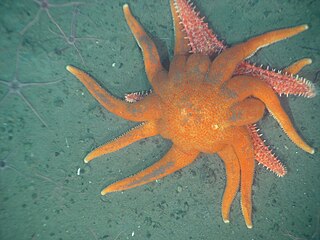
The Valvatida are an order of starfish in the class Asteroidea, which contains 695 species in 172 genera in 17 families.
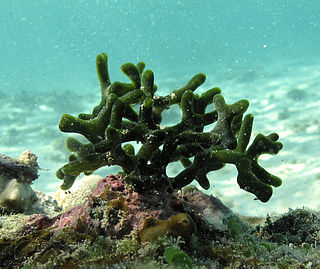
Codium is a genus of seaweed in the Chlorophyta of the order Bryopsidales. Paul Silva was an expert on the genus Codium taxonomy at the University of California at Berkeley. There are about 50 species worldwide.
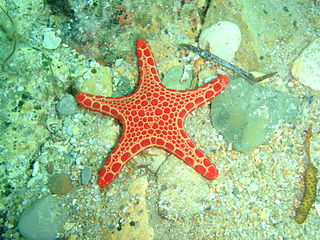
Goniasteridae constitute the largest family of sea stars, included in the order Valvatida. They are mostly deep-dwelling species, but the family also include several colorful shallow tropical species.

Culcita is a genus of cushion stars. They are found in tropical waters. Some are kept in home aquariums.

Nidorellia armata, also known as the chocolate chip star, is a species of starfish from warmer parts of the East Pacific, where it ranges from the Gulf of California to northwest Peru, including the Galápagos. It is the only species in the genus Nidorellia. N. armata can be found in tropical waters clinging on corals and rocky reefs; and are sometimes kept as pets in home marine aquariums.
Astrometis sertulifera, the fragile rainbow star, is the only uncontested species of sea star in the genus Astrometis.

Pisaster ochraceus, generally known as the purple sea star, ochre sea star, or ochre starfish, is a common starfish found among the waters of the Pacific Ocean. Identified as a keystone species, P. ochraceus is considered an important indicator for the health of the intertidal zone.
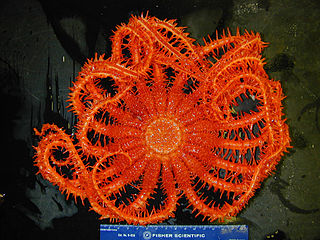
The Brisingids are deep-sea-dwelling starfish in the order Brisingida.
Stylasterias is a genus of starfish in the family Asteriidae. Stylasterias forreri, the velcro star, is the only species in the genus. It is found on the Pacific coast of Canada and the United States.
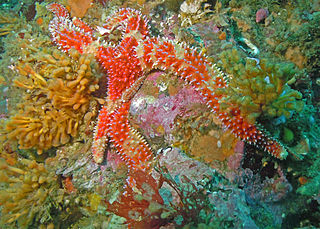
Orthasterias is a genus of sea stars in the family Asteriidae. Orthasterias koehleri, the rainbow star or red-banded sea star, is the only species in the genus. It is found in the North Pacific Ocean.

Hippasteria is one of 70 genera of sea star in the diverse family Goniasteridae.

Astropecten armatus, the spiny sand star or Estrella de Arena, is a sea star in the family Astropectinidae. It is found on sandy or gravelly areas in the East Pacific ranging from California (USA) to Ecuador.

Sea star wasting disease or starfish wasting syndrome is a disease of starfish and several other echinoderms that appears sporadically, causing mass mortality of those affected. There are around 40 different species of sea stars that have been affected by this disease. The disease seems to be associated with raised water temperatures in some places, but not others. It starts with the emergence of lesions, followed by body fragmentation and death. In 2014 it was suggested that the disease is associated with a single-stranded DNA virus now known as the sea star-associated densovirus (SSaDV); however, sea star wasting disease is still not fully understood.

Heliaster kubiniji is a species of starfish in the order Forcipulatida. It is commonly known as the gulf sun star, the common sun star or estrella de mar de golfo and it occurs in the intertidal zone of the Pacific coast of California, Mexico and Nicaragua.

Evoplosoma is a genus of deep-sea sea star in the family Goniasteridae.

Circeaster is a genus of abyssal sea stars in the family Goniasteridae.
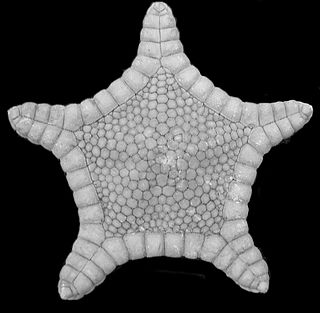
Astroceramus is a genus of abyssal sea stars in the family Goniasteridae.

Apollonaster is a genus of abyssal sea stars in the family Goniasteridae. They can be identified by their bare abactinal plate surfaces and multiple accessory granule rows on their abactinal plates. To date, Apollonaster has been found in the tropical Atlantic region and Hawaiian Islands region oceans, with no other locations or species being known as of 2015.
References
- ITIS Standard Report Page: Astrometis
- Mah, C. (2014). Mah CL (ed.). "Astrometis Fisher, 1923". World Asteroidea database. World Register of Marine Species . Retrieved 2014-05-23.
- CalPhotos: Astrometis sertulifera; Fragile Rainbow Star
- Morris, R.H.; Abbot, D.P.; Haderlie, E.C. (1980). Intertidal Invertebrates of California. Stanford CA: Stanford University Press. p. 122. ISBN 9780804710459.